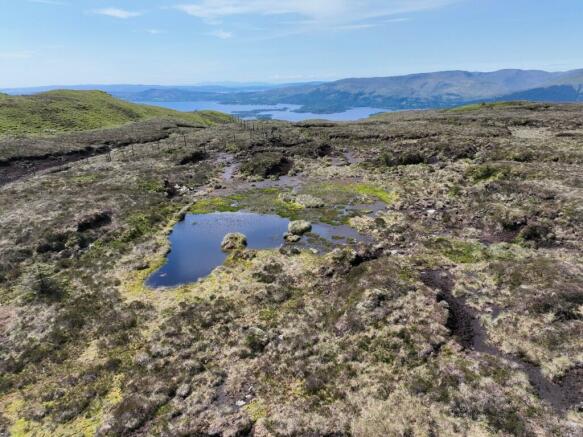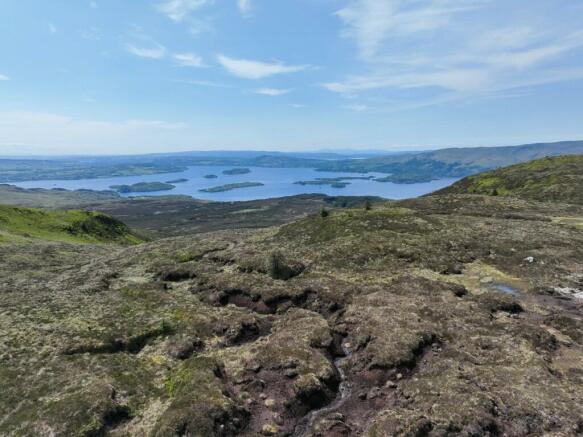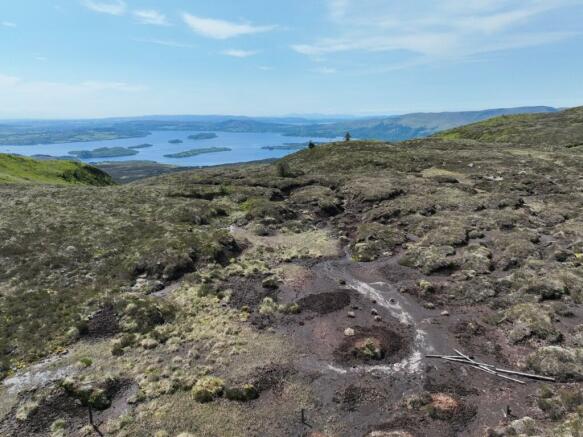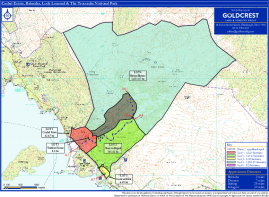Beinn Bhreac Hill, Loch Lomond G63
- SIZE AVAILABLE
113,136,124 sq ft
10,510,700 sq m
- SECTOR
Land for sale
Key features
- Beinn Bhreac Hill - Area: 1,051.07 Hectares / 2,597.19 Acres
- The current peatland restoration project at Cashel is estimated to yield around 33,000 tCO2e in emissions reductions.
Description
Location
Cashel Forest Estate lies within the heart of Loch Lomond and the Trossachs National Park, on the east side of Loch Lomond itself, between the village of Drymen to the south and Ben Lomond to the north. The Estate is accessed directly off a "C" classified public road, which runs north from the village of Balmaha, along the eastern shores of Loch Lomond to Rowardennan (approximately four miles north of the estate), where the public road terminates.
Balmaha retains a number of tourist facilities, with nearest small town services available in Drymen, approximately seven miles south of the Estate. Larger town services are available in a number of towns to the south and east with Glasgow City Centre being approximately twenty six miles.
The Estate
Cashel comprises about 1,242 hectares (3,069 acres) of hillsides, moorland and native woodlands, rich in natural assets and offering significant potential for carbon and biodiversity-based projects.
The Estate is managed by the Cashel Forest Trust principally as a native forest with public access encouraged, along with forestry education activities. Extensive areas of the open hill are managed for peatland restoration.
Cashel Forest Trust has crafted a network of walking paths, some of which are wheelchair compatible, showcasing the finest features of the Estate. These paths wind through captivating landscapes, past the UK's largest wild crab tree, and offering breathtaking views over Loch Lomond, its islands and surrounding hills. Picnic benches, bridges, and informative boards are strategically placed across the Estate for public enjoyment.
The Cashel Burn generates sustainable electricity for the national grid.
The abundance of wildlife at Cashel is remarkable, with resident badgers, red, roe and occasionally fallow deer, adders, red squirrels, pine martens, otters, water voles, and a diverse array of birds. The trust is dedicated to nature conservation, fostering "wildlife corridors" connecting the Loch Lomond and Loch Ard catchments.
Owner's Objectives
Cashel Forest Trust was set up in 1996 when they took ownership of the Estate. The primary objective of the purchase was to demonstrate the restoration and regeneration of Scotland's native woods through sound forestry practice, for the benefit of the public.
The Trust is run by volunteers who have considerable knowledge and experience in woodland creation, land management and conservation.
When the woodland was ten years old a report and management plan entitled Cashel - The Forest for a Thousand Years was commissioned. A copy is available from Goldcrest Land & Forestry Group.
Land
The land lies at a height of between 20 meters above sea level, along the south west boundary, rising to the high point at Binnean nan Gobhar at 586 meters above sea level. The peak forms part of a central ridge line and watershed. A significant portion of the Estate's upland area lies beyond the watershed, to the east and north east, forming part of the Loch Ard catchment area.
Woodland
The oak woods of Loch Lomond have a long history and represent some of the largest remnants of semi-natural woodlands in the country. In the 18th century, the woods were systematically managed and converted to oak 'coppice-with-standards' with the smaller timber managed for bark, leather tanning and charcoal. The larger timber used for boat building, more general domestic and Estate use. There is about 24 hectares of such beautiful, remnant oakwood at Cashel.
Between 1997 and 2001, the current owners undertook a programme of native species planting, mainly on the lower slopes. Mixed broadleaved species including Oak, both sessile and pedunculate and birch with scattered groups of ash, aspen, alder, gean, hazel, holly, juniper and willow were successfully established.
Some Scots pine was also planted on suitable sites and there is now an opportunity for thinning.
Some "montane scrub" planting plots have been established on the moorland. There is additional scope for further tree planting and to expand the woodland area by natural regeneration. In general, these important woodlands are managed on a non commercial basis, for the benefit of conservation, leisure and public access. At all times promoting the existing ancient/native woodland and encouraging the growth of mixed native tree species. There is an abundance of wildlife thriving from these management practises. A Natural Capital Report dated 2021 and the Long- Term Forest Plan are both available from the Selling Agent.
Peatland
Much of the hill land, 845 hectares, is peatland - made up of nationally important Class 1 and Class 2 carbon-rich soils, deep peats (maximum peat depth recorded >4.5m) and priority peatland habitat of high conservation value.
In partnership with NatureScot and LLTNPA, grant funding from Peatland ACTION aided the restoration of around 80 hectares of degraded peatland during "Phase 1" works in early 2024. A further circa 140 hectares of Peatland ACTION funded restoration work - "Phase 2" - is scheduled to start in September 2024.
The current peatland restoration project at Cashel is estimated to yield around 33,000 tCO2e in emissions reductions. The project is currently in the final stages of Peatland Code "Project Plan Validation" and is expected to result in around 28,000 tCO2e of claimable emissions reductions (after deductions for the Peatland Code risk buffer). This will correspond to around 28,000 Pending Issuance Units (PIUs) which are expected to be issued later in 2024, and will be included in the sale of Lot 4.
It is anticipated that further peatland restoration beyond the current works will be possible at Cashel, which could also lead to further gains of saleable peatland carbon subject to Peatland Code eligibility tests.
Lot 4 - Beinn Bhreac Hill
Area: 1,051.07 Hectares / 2,597.19 Acres
Guide Price: Offers over £2,250,000
A substantial area of attractive hill ground with some montane planting. There are large areas of degraded peatland which have been included in the restoration scheme. Phase 1 is now complete on 80 hectares. Phase 2 comprising 140 hectares is now underway. It is believed that there is Carbon Credit potential for a total of 28,000 Pending Issuance Units (PIUs) which are expected to be issued later in 2024. The current peatland restoration project at Cashel is estimated to yield around 33,000 tCO2e in emissions reductions.
Within the upper watershed areas of the hill, there are a number of fenced off, trial "montane scrub" planting plots. Beinn Bhreac offers a rare opportunity to play a key role in the ongoing stewardship and management of this stunning landscape, in a most important location.
Access is taken from the hill road A1-A6. There is a right over access over the road owned by Cashel Glen Forest.
Forest Grants
There are no forest grants in place.
Boundaries
Boundaries on the lower grazing ground comprise mainly post and wire fencing in reasonable stock proof condition. Woodland and hill boundary areas are demarked by a mixture of deer fencing, which is of mixed repair (deer proof in places and severely broken in others). The south east march on the hill is generally unfenced, however, as the hill is not grazed by livestock this is not considered to be an issue.
Sporting
Red and Roe and occasional fallow deer are present on the holding. A shooting tenant is in place with a remit to increase the cull level to reduce deer browsing and allow natural regeneration to occur and allow expansion of the woodland area out from existing areas. The lease is available from the Selling Agent. There is the right to launch a boat and riparian fishing rights on Loch Lomond.
Wayleaves & Servitudes
The owners of Cashel Glen Forest retain full access rights from the public road along the Cashel Estate access road and car park onto the hill road, for all purposes. Maintenance for this access is shared on a user basis.
The lower lying land is crossed by a single pole electricity line for which there is servitude rights to access and maintain.
The West Highland Way passes alongside the western edge of the property.
Mineral Rights
Mineral rights over part of the property have been retained by a previous title and are not included in the sale.
Viewing
Viewing is strictly by appointment only, please contact the Selling Agents.
Brochures
Beinn Bhreac Hill, Loch Lomond G63
NEAREST STATIONS
Distances are straight line measurements from the centre of the postcode- Balloch Station8.5 miles
Notes
Disclaimer - Property reference cashellot4. The information displayed about this property comprises a property advertisement. Rightmove.co.uk makes no warranty as to the accuracy or completeness of the advertisement or any linked or associated information, and Rightmove has no control over the content. This property advertisement does not constitute property particulars. The information is provided and maintained by GOLDCREST LAND & FORESTRY GROUP LLP, Edinburgh. Please contact the selling agent or developer directly to obtain any information which may be available under the terms of The Energy Performance of Buildings (Certificates and Inspections) (England and Wales) Regulations 2007 or the Home Report if in relation to a residential property in Scotland.
Map data ©OpenStreetMap contributors.





